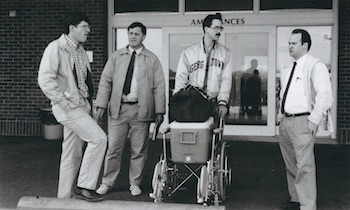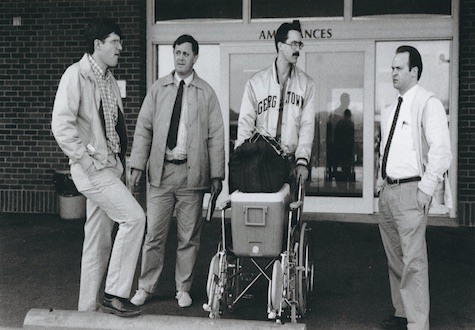
When Leslie E. Rudolph, MD, performed UVA’s first kidney transplant on June 13, 1967, many still thought of organ transplant as an experimental treatment.
The idea of a healthy person being “harmed” by removing an organ to improve the health of another person was still controversial in some circles. Organ rejection — still a concern today — was the overriding concern. Twins were the best match, followed by siblings and parents. The common induction and maintenance drugs used today were still decades away from being perfected.
It was the beginning of a new period of innovation, but what nobody predicted in the stories at the time was how much the transplant program at UVA brought people together, strengthening connections between families, friends, doctors, nurses, transplant coordinators and even strangers.
The First Organ Donors Were Family Members
The first organ transplants were between twins because the recipient’s body would not recognize the new kidney as foreign and thus not produce an immune response. When transplants proved successful, and as doctors and researchers improved anti-rejection medications, other blood relatives and then donors who were not related to the organ transplant recipient would be tested to see if they were suitable donors.
Are You an Organ Donor?
Become one and change someone’s life.
UVA’s transplant program steadily moved forward. When UVA established the heart transplant program in 1988, Kate Fitzgerald, transplant coordinator, mused “Someday we’d like to include lung and pancreas transplants.”
A kidney transplant recipient who was thrilled to receive a healthy kidney from his brother in 1984 wondered if a pancreas transplant would ever be possible to cure people like him of the type-1 diabetes that he’d had since birth. By the end of the decade, UVA had established programs in heart, kidney, pancreas, lung, liver and bone marrow transplant.
More Transplant Anniversaries, More Milestones
Successful organ transplants led to more innovation and more demand. As doctors recommended transplants for their patients, the need for donors increased. Some families relied on other family members, like Andrea Vest, whose daughter, Tarpley Gillespie, donated her kidney. Quincy Waller went through the evaluation process to donate a portion of his liver to his wife, Leslie. While he was a perfect match, she ended up using a deceased donor.
When researching this story, I marveled at how many people found out about their friend, colleague or fraternity brother needed their help and how many people willingly come forward. A daughter donates her kidney to her father; a son, who himself is a father of three, donates his kidney to his father. A brother who describes himself as “kind of a carouser” but still met the donation criteria donates his kidney to his brother who suffered from diabetes. And then there are the donors that changed several lives, like the father of four and husband of a UVA doctor, who died suddenly at 36 and donated his organs, eyes and skin to eight grateful recipients.
At every celebratory milestone for the organ transplant program, whether it was the 25th anniversary in 1992 or the 40th anniversary in 2007 or at the 50th anniversary this year, organ donation awareness has always been a constant focus. Organ donors change and sometimes save people’s lives every day.
The Organ Transplant Team
Another thing that hasn’t changed over the years is the dedication of the transplant team and the logistics involved in getting the organ to the patient in need. A 1989 profile of Wendell Dodd, transplant coordinator, follows him through a day where he gets the call and has to travel to New England and back and shepherd the team through two surgeries in one day. “Every minute counts,” he says “There can be no waiting, no fumbling.”
The same urgency and attention to logistics and detail remains today. While the branding might be fancier, organs are still transported in coolers and the organ transplant surgeon removes the organ from the donor and performs the transplant surgery for the recipient. The teams are larger and care for more patients today, but they rely on the same process.
